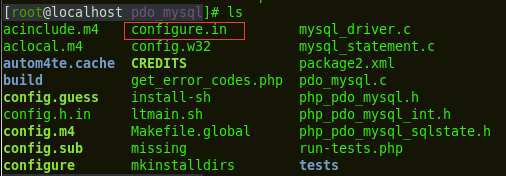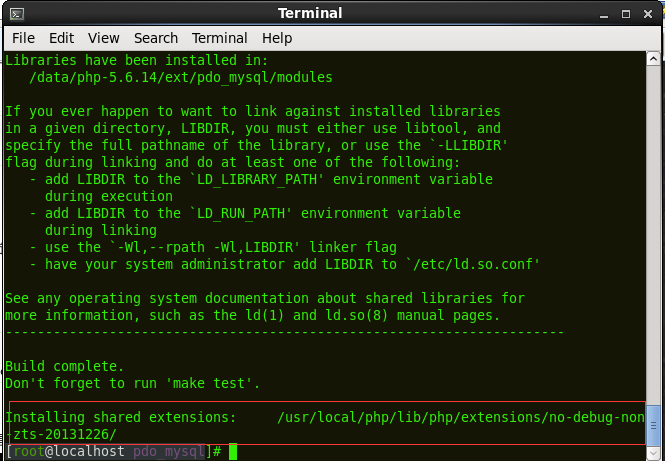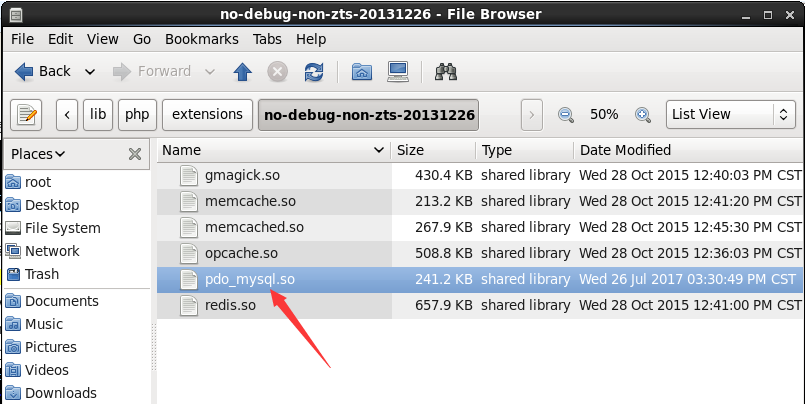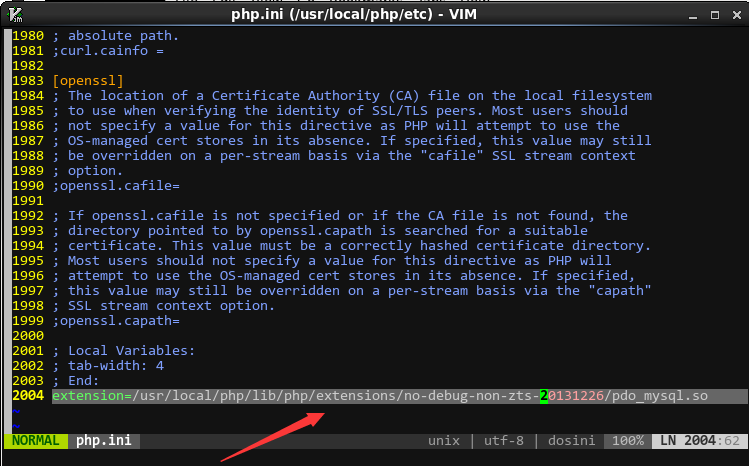Install PDO extension for PHP on CentOS
PHP Data Object PDO extension defines a lightweight consistent interface for PHP to access the database. PDO provides a data access abstraction layer, which means that no matter which database is used, the same functions (methods) can be used to query and obtain data.
environment:Server system: Centos6.5 (virtual machine demonstration)
PHP software package storage directory:/data/php-5.6.14/
PHP installation directory:/usr/local/php/
mysql installation directory:/usr/local/mysql/
Operating procedures:Through the phpinfo() function we can check whether the PDO extension is installed on the server. If the PDO extension information is not found, then we install it through the following steps:
Find your PHP installation package (mine is placed in the /data/php-5.6.14/ directory), enter the pdo_mysql directory of the PHP extension, and run the following command:
/usr/local/php/bin/phpize
(/usr/local/php/ is my PHP installation directory, you can modify it according to the actual situation)

After executing the above command, we will find that the configure file appears in the current pdo_msyql directory.

However, we execute the following command:
./configure --with-php-config=/usr/local/php/bin/php-config --with-pdo-mysql=/usr/local/mysql/
Parameter Description:
--with-php-config=/usr/local/php/bin/php-config Specifies the configuration when installing PHP
--with-pdo-MySQL=/usr/local/mysql/ Specify the installation directory location of the MySQL database
(The specific installation directory of PHP and msyql here depends on your actual situation)
Continue to compile and install:
make && make install
After the command is executed, the effect is as follows:

The directory that is sufficient for the last line will be used later. The pdo_mysql.so file generated at this time is in this directory:

Next we modify the PHP configuration file, open your php.ini file, and add a line of code:
extension=/usr/local/php/lib/php/extensions/no-debug-non-zts-20131226/pdo_mysql.so
(Here is the pdo_mysql.so directory I demonstrated. You can add it according to your actual directory when setting up)

Finally save and launch, and restart the service. Then use the phpinfo() function to check whether the PDO extension is installed successfully. The results are as follows, indicating that the PDO extension is installed successfully.

The above is the detailed content of Install PDO extension for PHP on CentOS. For more information, please follow other related articles on the PHP Chinese website!

Hot AI Tools

Undresser.AI Undress
AI-powered app for creating realistic nude photos

AI Clothes Remover
Online AI tool for removing clothes from photos.

Undress AI Tool
Undress images for free

Clothoff.io
AI clothes remover

Video Face Swap
Swap faces in any video effortlessly with our completely free AI face swap tool!

Hot Article

Hot Tools

Notepad++7.3.1
Easy-to-use and free code editor

SublimeText3 Chinese version
Chinese version, very easy to use

Zend Studio 13.0.1
Powerful PHP integrated development environment

Dreamweaver CS6
Visual web development tools

SublimeText3 Mac version
God-level code editing software (SublimeText3)

Hot Topics
 1664
1664
 14
14
 1423
1423
 52
52
 1318
1318
 25
25
 1269
1269
 29
29
 1248
1248
 24
24
 Linux Architecture: Unveiling the 5 Basic Components
Apr 20, 2025 am 12:04 AM
Linux Architecture: Unveiling the 5 Basic Components
Apr 20, 2025 am 12:04 AM
The five basic components of the Linux system are: 1. Kernel, 2. System library, 3. System utilities, 4. Graphical user interface, 5. Applications. The kernel manages hardware resources, the system library provides precompiled functions, system utilities are used for system management, the GUI provides visual interaction, and applications use these components to implement functions.
 How to check the warehouse address of git
Apr 17, 2025 pm 01:54 PM
How to check the warehouse address of git
Apr 17, 2025 pm 01:54 PM
To view the Git repository address, perform the following steps: 1. Open the command line and navigate to the repository directory; 2. Run the "git remote -v" command; 3. View the repository name in the output and its corresponding address.
 How to run java code in notepad
Apr 16, 2025 pm 07:39 PM
How to run java code in notepad
Apr 16, 2025 pm 07:39 PM
Although Notepad cannot run Java code directly, it can be achieved by using other tools: using the command line compiler (javac) to generate a bytecode file (filename.class). Use the Java interpreter (java) to interpret bytecode, execute the code, and output the result.
 How to run sublime after writing the code
Apr 16, 2025 am 08:51 AM
How to run sublime after writing the code
Apr 16, 2025 am 08:51 AM
There are six ways to run code in Sublime: through hotkeys, menus, build systems, command lines, set default build systems, and custom build commands, and run individual files/projects by right-clicking on projects/files. The build system availability depends on the installation of Sublime Text.
 What is the main purpose of Linux?
Apr 16, 2025 am 12:19 AM
What is the main purpose of Linux?
Apr 16, 2025 am 12:19 AM
The main uses of Linux include: 1. Server operating system, 2. Embedded system, 3. Desktop operating system, 4. Development and testing environment. Linux excels in these areas, providing stability, security and efficient development tools.
 laravel installation code
Apr 18, 2025 pm 12:30 PM
laravel installation code
Apr 18, 2025 pm 12:30 PM
To install Laravel, follow these steps in sequence: Install Composer (for macOS/Linux and Windows) Install Laravel Installer Create a new project Start Service Access Application (URL: http://127.0.0.1:8000) Set up the database connection (if required)
 git software installation
Apr 17, 2025 am 11:57 AM
git software installation
Apr 17, 2025 am 11:57 AM
Installing Git software includes the following steps: Download the installation package and run the installation package to verify the installation configuration Git installation Git Bash (Windows only)
 How to run sublime python
Apr 16, 2025 am 08:54 AM
How to run sublime python
Apr 16, 2025 am 08:54 AM
How to run Python scripts in Sublime Text: Install Python interpreter configuration Interpreter path in Sublime Text Press Ctrl B (Windows/Linux) or Cmd B (macOS) to run the script If an interactive console is required, press Ctrl \ (Windows/Linux) or Cmd \ (macOS)




